supporting the individual journey passing from medical treatment
VerifiedAdded on 2022/07/27
|15
|5501
|39
AI Summary
Contribute Materials
Your contribution can guide someone’s learning journey. Share your
documents today.

Unit 3: supporting the individual journey through integrated helath And social care
Secure Best Marks with AI Grader
Need help grading? Try our AI Grader for instant feedback on your assignments.
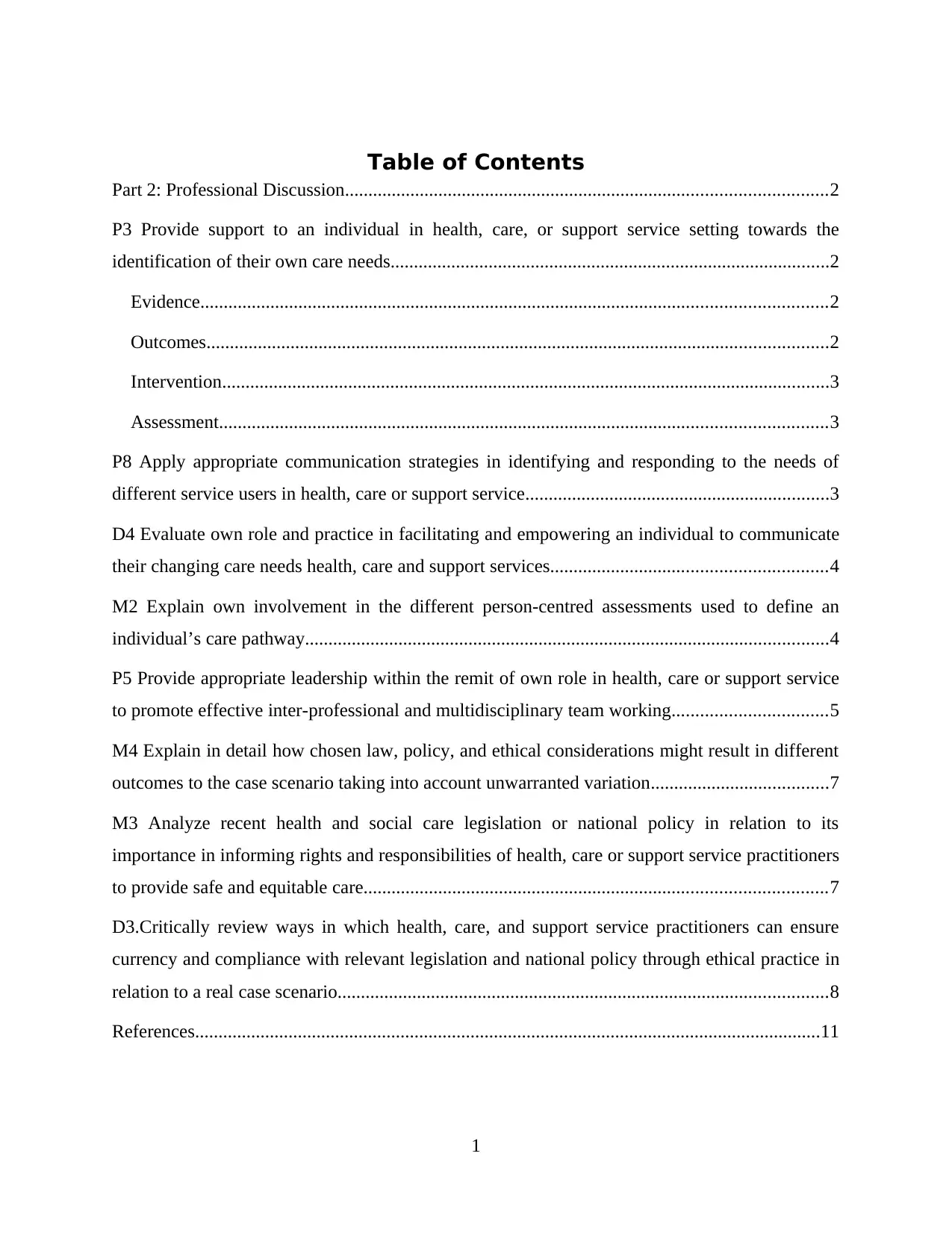
Table of Contents
Part 2: Professional Discussion.......................................................................................................2
P3 Provide support to an individual in health, care, or support service setting towards the
identification of their own care needs..............................................................................................2
Evidence......................................................................................................................................2
Outcomes.....................................................................................................................................2
Intervention..................................................................................................................................3
Assessment..................................................................................................................................3
P8 Apply appropriate communication strategies in identifying and responding to the needs of
different service users in health, care or support service.................................................................3
D4 Evaluate own role and practice in facilitating and empowering an individual to communicate
their changing care needs health, care and support services...........................................................4
M2 Explain own involvement in the different person-centred assessments used to define an
individual’s care pathway................................................................................................................4
P5 Provide appropriate leadership within the remit of own role in health, care or support service
to promote effective inter-professional and multidisciplinary team working.................................5
M4 Explain in detail how chosen law, policy, and ethical considerations might result in different
outcomes to the case scenario taking into account unwarranted variation......................................7
M3 Analyze recent health and social care legislation or national policy in relation to its
importance in informing rights and responsibilities of health, care or support service practitioners
to provide safe and equitable care...................................................................................................7
D3.Critically review ways in which health, care, and support service practitioners can ensure
currency and compliance with relevant legislation and national policy through ethical practice in
relation to a real case scenario.........................................................................................................8
References......................................................................................................................................11
1
Part 2: Professional Discussion.......................................................................................................2
P3 Provide support to an individual in health, care, or support service setting towards the
identification of their own care needs..............................................................................................2
Evidence......................................................................................................................................2
Outcomes.....................................................................................................................................2
Intervention..................................................................................................................................3
Assessment..................................................................................................................................3
P8 Apply appropriate communication strategies in identifying and responding to the needs of
different service users in health, care or support service.................................................................3
D4 Evaluate own role and practice in facilitating and empowering an individual to communicate
their changing care needs health, care and support services...........................................................4
M2 Explain own involvement in the different person-centred assessments used to define an
individual’s care pathway................................................................................................................4
P5 Provide appropriate leadership within the remit of own role in health, care or support service
to promote effective inter-professional and multidisciplinary team working.................................5
M4 Explain in detail how chosen law, policy, and ethical considerations might result in different
outcomes to the case scenario taking into account unwarranted variation......................................7
M3 Analyze recent health and social care legislation or national policy in relation to its
importance in informing rights and responsibilities of health, care or support service practitioners
to provide safe and equitable care...................................................................................................7
D3.Critically review ways in which health, care, and support service practitioners can ensure
currency and compliance with relevant legislation and national policy through ethical practice in
relation to a real case scenario.........................................................................................................8
References......................................................................................................................................11
1
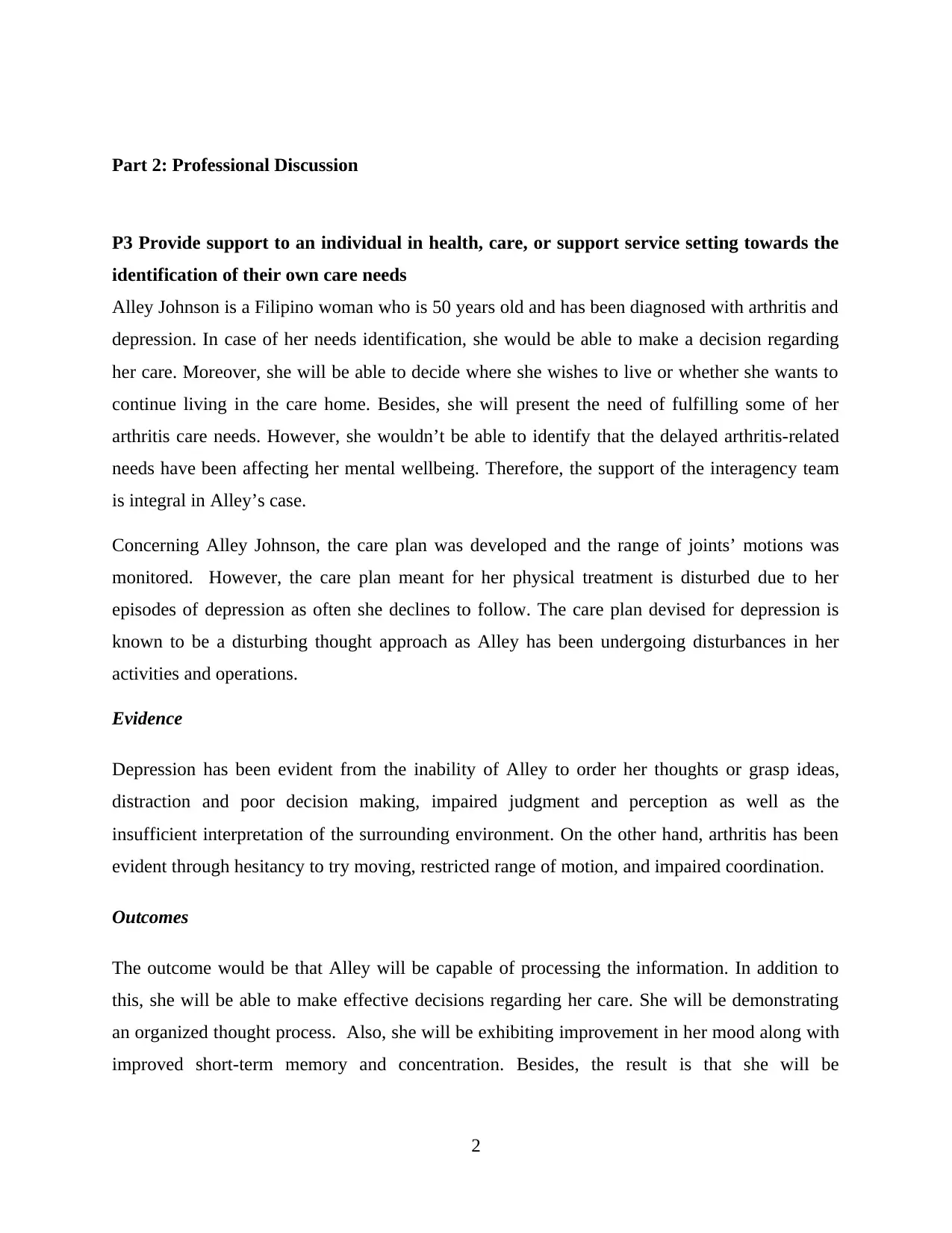
Part 2: Professional Discussion
P3 Provide support to an individual in health, care, or support service setting towards the
identification of their own care needs
Alley Johnson is a Filipino woman who is 50 years old and has been diagnosed with arthritis and
depression. In case of her needs identification, she would be able to make a decision regarding
her care. Moreover, she will be able to decide where she wishes to live or whether she wants to
continue living in the care home. Besides, she will present the need of fulfilling some of her
arthritis care needs. However, she wouldn’t be able to identify that the delayed arthritis-related
needs have been affecting her mental wellbeing. Therefore, the support of the interagency team
is integral in Alley’s case.
Concerning Alley Johnson, the care plan was developed and the range of joints’ motions was
monitored. However, the care plan meant for her physical treatment is disturbed due to her
episodes of depression as often she declines to follow. The care plan devised for depression is
known to be a disturbing thought approach as Alley has been undergoing disturbances in her
activities and operations.
Evidence
Depression has been evident from the inability of Alley to order her thoughts or grasp ideas,
distraction and poor decision making, impaired judgment and perception as well as the
insufficient interpretation of the surrounding environment. On the other hand, arthritis has been
evident through hesitancy to try moving, restricted range of motion, and impaired coordination.
Outcomes
The outcome would be that Alley will be capable of processing the information. In addition to
this, she will be able to make effective decisions regarding her care. She will be demonstrating
an organized thought process. Also, she will be exhibiting improvement in her mood along with
improved short-term memory and concentration. Besides, the result is that she will be
2
P3 Provide support to an individual in health, care, or support service setting towards the
identification of their own care needs
Alley Johnson is a Filipino woman who is 50 years old and has been diagnosed with arthritis and
depression. In case of her needs identification, she would be able to make a decision regarding
her care. Moreover, she will be able to decide where she wishes to live or whether she wants to
continue living in the care home. Besides, she will present the need of fulfilling some of her
arthritis care needs. However, she wouldn’t be able to identify that the delayed arthritis-related
needs have been affecting her mental wellbeing. Therefore, the support of the interagency team
is integral in Alley’s case.
Concerning Alley Johnson, the care plan was developed and the range of joints’ motions was
monitored. However, the care plan meant for her physical treatment is disturbed due to her
episodes of depression as often she declines to follow. The care plan devised for depression is
known to be a disturbing thought approach as Alley has been undergoing disturbances in her
activities and operations.
Evidence
Depression has been evident from the inability of Alley to order her thoughts or grasp ideas,
distraction and poor decision making, impaired judgment and perception as well as the
insufficient interpretation of the surrounding environment. On the other hand, arthritis has been
evident through hesitancy to try moving, restricted range of motion, and impaired coordination.
Outcomes
The outcome would be that Alley will be capable of processing the information. In addition to
this, she will be able to make effective decisions regarding her care. She will be demonstrating
an organized thought process. Also, she will be exhibiting improvement in her mood along with
improved short-term memory and concentration. Besides, the result is that she will be
2
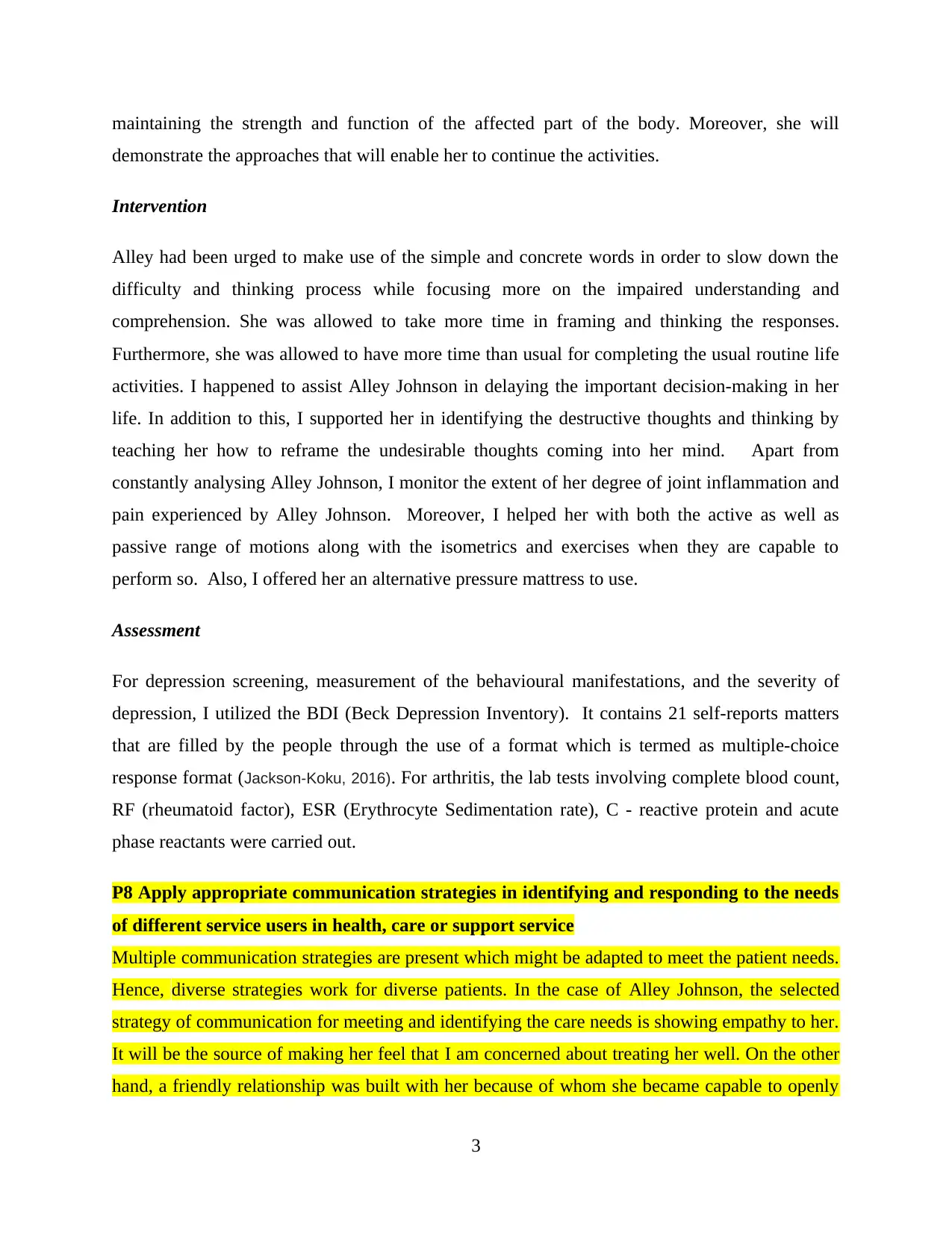
maintaining the strength and function of the affected part of the body. Moreover, she will
demonstrate the approaches that will enable her to continue the activities.
Intervention
Alley had been urged to make use of the simple and concrete words in order to slow down the
difficulty and thinking process while focusing more on the impaired understanding and
comprehension. She was allowed to take more time in framing and thinking the responses.
Furthermore, she was allowed to have more time than usual for completing the usual routine life
activities. I happened to assist Alley Johnson in delaying the important decision-making in her
life. In addition to this, I supported her in identifying the destructive thoughts and thinking by
teaching her how to reframe the undesirable thoughts coming into her mind. Apart from
constantly analysing Alley Johnson, I monitor the extent of her degree of joint inflammation and
pain experienced by Alley Johnson. Moreover, I helped her with both the active as well as
passive range of motions along with the isometrics and exercises when they are capable to
perform so. Also, I offered her an alternative pressure mattress to use.
Assessment
For depression screening, measurement of the behavioural manifestations, and the severity of
depression, I utilized the BDI (Beck Depression Inventory). It contains 21 self-reports matters
that are filled by the people through the use of a format which is termed as multiple-choice
response format (Jackson-Koku, 2016). For arthritis, the lab tests involving complete blood count,
RF (rheumatoid factor), ESR (Erythrocyte Sedimentation rate), C - reactive protein and acute
phase reactants were carried out.
P8 Apply appropriate communication strategies in identifying and responding to the needs
of different service users in health, care or support service
Multiple communication strategies are present which might be adapted to meet the patient needs.
Hence, diverse strategies work for diverse patients. In the case of Alley Johnson, the selected
strategy of communication for meeting and identifying the care needs is showing empathy to her.
It will be the source of making her feel that I am concerned about treating her well. On the other
hand, a friendly relationship was built with her because of whom she became capable to openly
3
demonstrate the approaches that will enable her to continue the activities.
Intervention
Alley had been urged to make use of the simple and concrete words in order to slow down the
difficulty and thinking process while focusing more on the impaired understanding and
comprehension. She was allowed to take more time in framing and thinking the responses.
Furthermore, she was allowed to have more time than usual for completing the usual routine life
activities. I happened to assist Alley Johnson in delaying the important decision-making in her
life. In addition to this, I supported her in identifying the destructive thoughts and thinking by
teaching her how to reframe the undesirable thoughts coming into her mind. Apart from
constantly analysing Alley Johnson, I monitor the extent of her degree of joint inflammation and
pain experienced by Alley Johnson. Moreover, I helped her with both the active as well as
passive range of motions along with the isometrics and exercises when they are capable to
perform so. Also, I offered her an alternative pressure mattress to use.
Assessment
For depression screening, measurement of the behavioural manifestations, and the severity of
depression, I utilized the BDI (Beck Depression Inventory). It contains 21 self-reports matters
that are filled by the people through the use of a format which is termed as multiple-choice
response format (Jackson-Koku, 2016). For arthritis, the lab tests involving complete blood count,
RF (rheumatoid factor), ESR (Erythrocyte Sedimentation rate), C - reactive protein and acute
phase reactants were carried out.
P8 Apply appropriate communication strategies in identifying and responding to the needs
of different service users in health, care or support service
Multiple communication strategies are present which might be adapted to meet the patient needs.
Hence, diverse strategies work for diverse patients. In the case of Alley Johnson, the selected
strategy of communication for meeting and identifying the care needs is showing empathy to her.
It will be the source of making her feel that I am concerned about treating her well. On the other
hand, a friendly relationship was built with her because of whom she became capable to openly
3
Secure Best Marks with AI Grader
Need help grading? Try our AI Grader for instant feedback on your assignments.
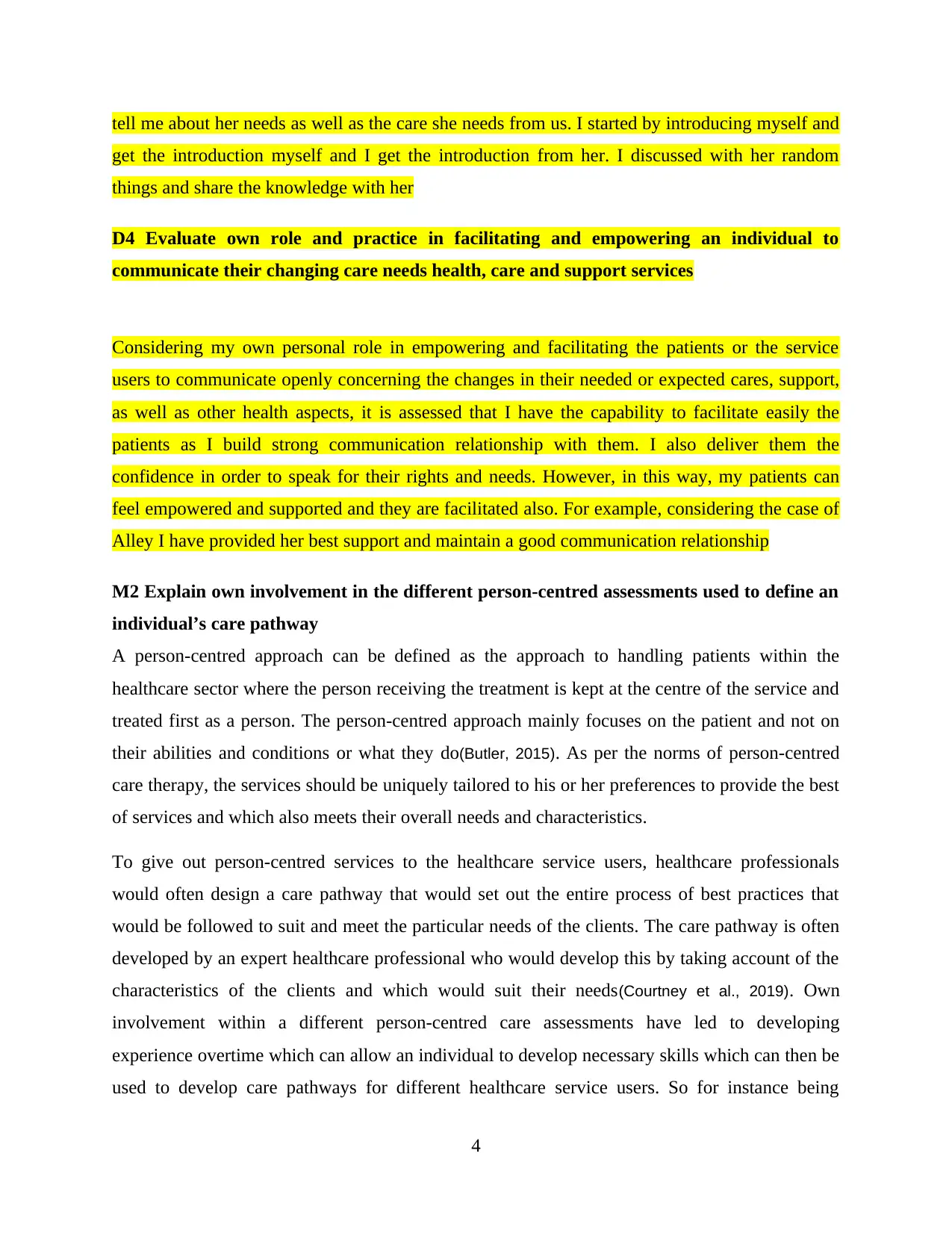
tell me about her needs as well as the care she needs from us. I started by introducing myself and
get the introduction myself and I get the introduction from her. I discussed with her random
things and share the knowledge with her
D4 Evaluate own role and practice in facilitating and empowering an individual to
communicate their changing care needs health, care and support services
Considering my own personal role in empowering and facilitating the patients or the service
users to communicate openly concerning the changes in their needed or expected cares, support,
as well as other health aspects, it is assessed that I have the capability to facilitate easily the
patients as I build strong communication relationship with them. I also deliver them the
confidence in order to speak for their rights and needs. However, in this way, my patients can
feel empowered and supported and they are facilitated also. For example, considering the case of
Alley I have provided her best support and maintain a good communication relationship
M2 Explain own involvement in the different person-centred assessments used to define an
individual’s care pathway
A person-centred approach can be defined as the approach to handling patients within the
healthcare sector where the person receiving the treatment is kept at the centre of the service and
treated first as a person. The person-centred approach mainly focuses on the patient and not on
their abilities and conditions or what they do(Butler, 2015). As per the norms of person-centred
care therapy, the services should be uniquely tailored to his or her preferences to provide the best
of services and which also meets their overall needs and characteristics.
To give out person-centred services to the healthcare service users, healthcare professionals
would often design a care pathway that would set out the entire process of best practices that
would be followed to suit and meet the particular needs of the clients. The care pathway is often
developed by an expert healthcare professional who would develop this by taking account of the
characteristics of the clients and which would suit their needs(Courtney et al., 2019). Own
involvement within a different person-centred care assessments have led to developing
experience overtime which can allow an individual to develop necessary skills which can then be
used to develop care pathways for different healthcare service users. So for instance being
4
get the introduction myself and I get the introduction from her. I discussed with her random
things and share the knowledge with her
D4 Evaluate own role and practice in facilitating and empowering an individual to
communicate their changing care needs health, care and support services
Considering my own personal role in empowering and facilitating the patients or the service
users to communicate openly concerning the changes in their needed or expected cares, support,
as well as other health aspects, it is assessed that I have the capability to facilitate easily the
patients as I build strong communication relationship with them. I also deliver them the
confidence in order to speak for their rights and needs. However, in this way, my patients can
feel empowered and supported and they are facilitated also. For example, considering the case of
Alley I have provided her best support and maintain a good communication relationship
M2 Explain own involvement in the different person-centred assessments used to define an
individual’s care pathway
A person-centred approach can be defined as the approach to handling patients within the
healthcare sector where the person receiving the treatment is kept at the centre of the service and
treated first as a person. The person-centred approach mainly focuses on the patient and not on
their abilities and conditions or what they do(Butler, 2015). As per the norms of person-centred
care therapy, the services should be uniquely tailored to his or her preferences to provide the best
of services and which also meets their overall needs and characteristics.
To give out person-centred services to the healthcare service users, healthcare professionals
would often design a care pathway that would set out the entire process of best practices that
would be followed to suit and meet the particular needs of the clients. The care pathway is often
developed by an expert healthcare professional who would develop this by taking account of the
characteristics of the clients and which would suit their needs(Courtney et al., 2019). Own
involvement within a different person-centred care assessments have led to developing
experience overtime which can allow an individual to develop necessary skills which can then be
used to develop care pathways for different healthcare service users. So for instance being
4
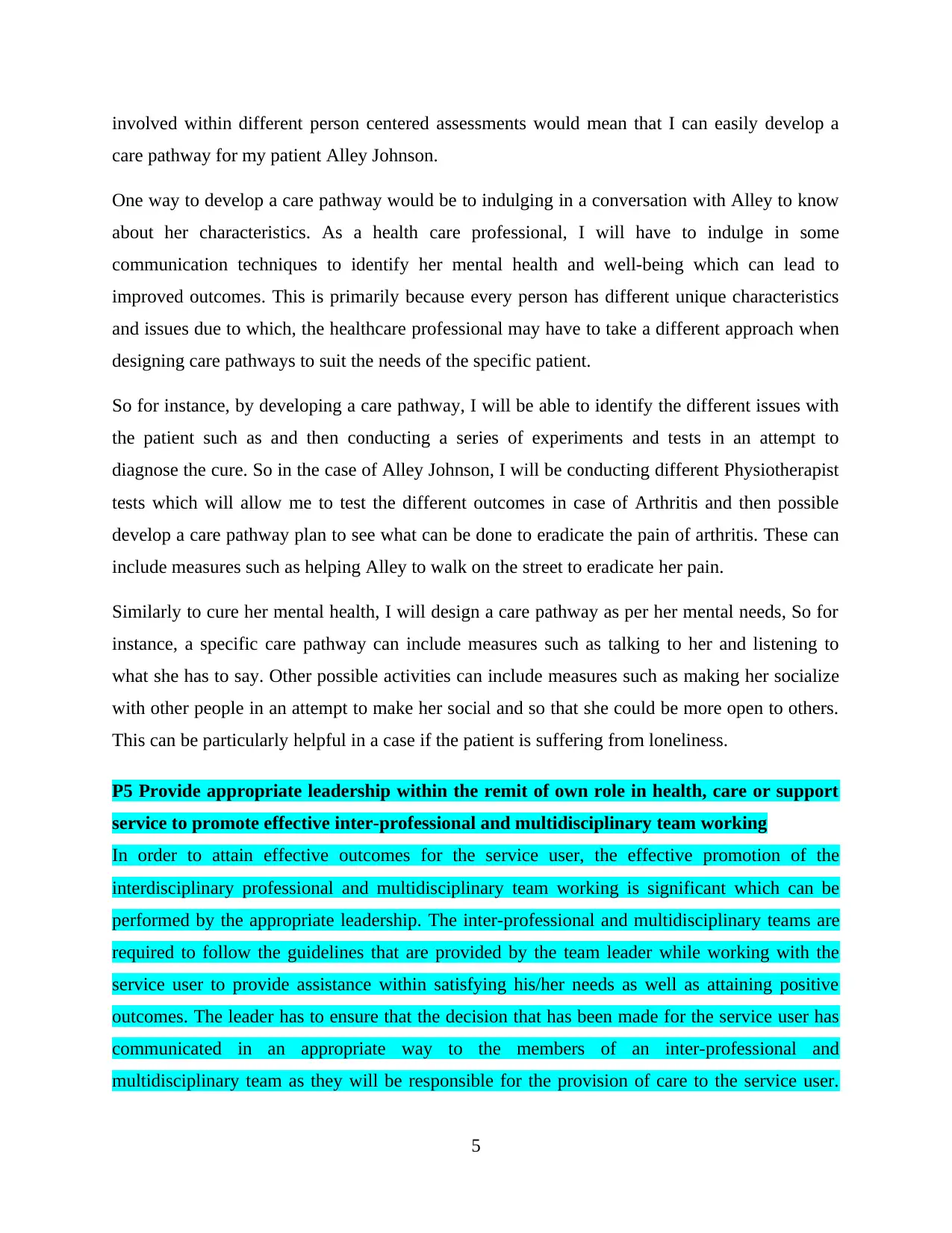
involved within different person centered assessments would mean that I can easily develop a
care pathway for my patient Alley Johnson.
One way to develop a care pathway would be to indulging in a conversation with Alley to know
about her characteristics. As a health care professional, I will have to indulge in some
communication techniques to identify her mental health and well-being which can lead to
improved outcomes. This is primarily because every person has different unique characteristics
and issues due to which, the healthcare professional may have to take a different approach when
designing care pathways to suit the needs of the specific patient.
So for instance, by developing a care pathway, I will be able to identify the different issues with
the patient such as and then conducting a series of experiments and tests in an attempt to
diagnose the cure. So in the case of Alley Johnson, I will be conducting different Physiotherapist
tests which will allow me to test the different outcomes in case of Arthritis and then possible
develop a care pathway plan to see what can be done to eradicate the pain of arthritis. These can
include measures such as helping Alley to walk on the street to eradicate her pain.
Similarly to cure her mental health, I will design a care pathway as per her mental needs, So for
instance, a specific care pathway can include measures such as talking to her and listening to
what she has to say. Other possible activities can include measures such as making her socialize
with other people in an attempt to make her social and so that she could be more open to others.
This can be particularly helpful in a case if the patient is suffering from loneliness.
P5 Provide appropriate leadership within the remit of own role in health, care or support
service to promote effective inter-professional and multidisciplinary team working
In order to attain effective outcomes for the service user, the effective promotion of the
interdisciplinary professional and multidisciplinary team working is significant which can be
performed by the appropriate leadership. The inter-professional and multidisciplinary teams are
required to follow the guidelines that are provided by the team leader while working with the
service user to provide assistance within satisfying his/her needs as well as attaining positive
outcomes. The leader has to ensure that the decision that has been made for the service user has
communicated in an appropriate way to the members of an inter-professional and
multidisciplinary team as they will be responsible for the provision of care to the service user.
5
care pathway for my patient Alley Johnson.
One way to develop a care pathway would be to indulging in a conversation with Alley to know
about her characteristics. As a health care professional, I will have to indulge in some
communication techniques to identify her mental health and well-being which can lead to
improved outcomes. This is primarily because every person has different unique characteristics
and issues due to which, the healthcare professional may have to take a different approach when
designing care pathways to suit the needs of the specific patient.
So for instance, by developing a care pathway, I will be able to identify the different issues with
the patient such as and then conducting a series of experiments and tests in an attempt to
diagnose the cure. So in the case of Alley Johnson, I will be conducting different Physiotherapist
tests which will allow me to test the different outcomes in case of Arthritis and then possible
develop a care pathway plan to see what can be done to eradicate the pain of arthritis. These can
include measures such as helping Alley to walk on the street to eradicate her pain.
Similarly to cure her mental health, I will design a care pathway as per her mental needs, So for
instance, a specific care pathway can include measures such as talking to her and listening to
what she has to say. Other possible activities can include measures such as making her socialize
with other people in an attempt to make her social and so that she could be more open to others.
This can be particularly helpful in a case if the patient is suffering from loneliness.
P5 Provide appropriate leadership within the remit of own role in health, care or support
service to promote effective inter-professional and multidisciplinary team working
In order to attain effective outcomes for the service user, the effective promotion of the
interdisciplinary professional and multidisciplinary team working is significant which can be
performed by the appropriate leadership. The inter-professional and multidisciplinary teams are
required to follow the guidelines that are provided by the team leader while working with the
service user to provide assistance within satisfying his/her needs as well as attaining positive
outcomes. The leader has to ensure that the decision that has been made for the service user has
communicated in an appropriate way to the members of an inter-professional and
multidisciplinary team as they will be responsible for the provision of care to the service user.
5
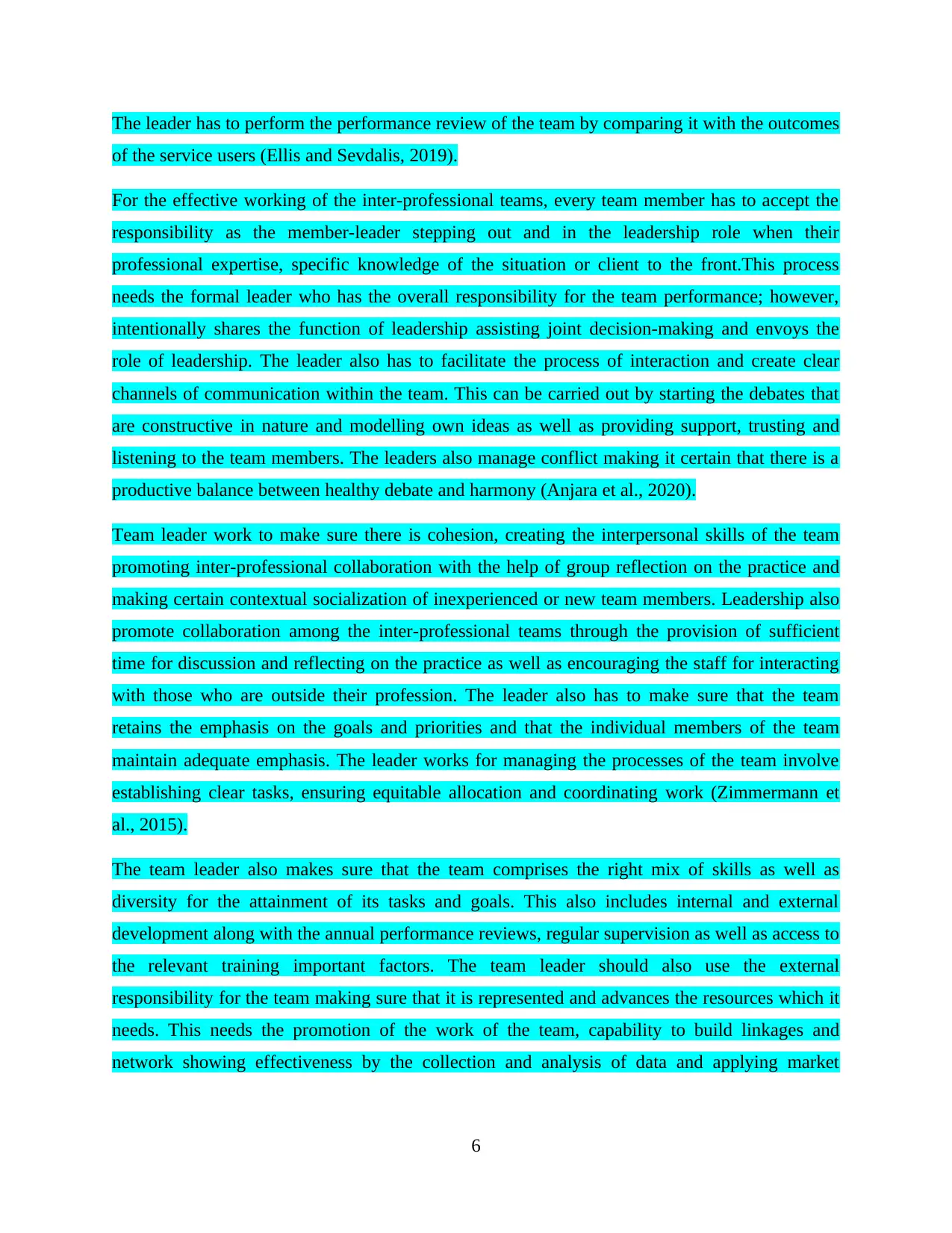
The leader has to perform the performance review of the team by comparing it with the outcomes
of the service users (Ellis and Sevdalis, 2019).
For the effective working of the inter-professional teams, every team member has to accept the
responsibility as the member-leader stepping out and in the leadership role when their
professional expertise, specific knowledge of the situation or client to the front.This process
needs the formal leader who has the overall responsibility for the team performance; however,
intentionally shares the function of leadership assisting joint decision-making and envoys the
role of leadership. The leader also has to facilitate the process of interaction and create clear
channels of communication within the team. This can be carried out by starting the debates that
are constructive in nature and modelling own ideas as well as providing support, trusting and
listening to the team members. The leaders also manage conflict making it certain that there is a
productive balance between healthy debate and harmony (Anjara et al., 2020).
Team leader work to make sure there is cohesion, creating the interpersonal skills of the team
promoting inter-professional collaboration with the help of group reflection on the practice and
making certain contextual socialization of inexperienced or new team members. Leadership also
promote collaboration among the inter-professional teams through the provision of sufficient
time for discussion and reflecting on the practice as well as encouraging the staff for interacting
with those who are outside their profession. The leader also has to make sure that the team
retains the emphasis on the goals and priorities and that the individual members of the team
maintain adequate emphasis. The leader works for managing the processes of the team involve
establishing clear tasks, ensuring equitable allocation and coordinating work (Zimmermann et
al., 2015).
The team leader also makes sure that the team comprises the right mix of skills as well as
diversity for the attainment of its tasks and goals. This also includes internal and external
development along with the annual performance reviews, regular supervision as well as access to
the relevant training important factors. The team leader should also use the external
responsibility for the team making sure that it is represented and advances the resources which it
needs. This needs the promotion of the work of the team, capability to build linkages and
network showing effectiveness by the collection and analysis of data and applying market
6
of the service users (Ellis and Sevdalis, 2019).
For the effective working of the inter-professional teams, every team member has to accept the
responsibility as the member-leader stepping out and in the leadership role when their
professional expertise, specific knowledge of the situation or client to the front.This process
needs the formal leader who has the overall responsibility for the team performance; however,
intentionally shares the function of leadership assisting joint decision-making and envoys the
role of leadership. The leader also has to facilitate the process of interaction and create clear
channels of communication within the team. This can be carried out by starting the debates that
are constructive in nature and modelling own ideas as well as providing support, trusting and
listening to the team members. The leaders also manage conflict making it certain that there is a
productive balance between healthy debate and harmony (Anjara et al., 2020).
Team leader work to make sure there is cohesion, creating the interpersonal skills of the team
promoting inter-professional collaboration with the help of group reflection on the practice and
making certain contextual socialization of inexperienced or new team members. Leadership also
promote collaboration among the inter-professional teams through the provision of sufficient
time for discussion and reflecting on the practice as well as encouraging the staff for interacting
with those who are outside their profession. The leader also has to make sure that the team
retains the emphasis on the goals and priorities and that the individual members of the team
maintain adequate emphasis. The leader works for managing the processes of the team involve
establishing clear tasks, ensuring equitable allocation and coordinating work (Zimmermann et
al., 2015).
The team leader also makes sure that the team comprises the right mix of skills as well as
diversity for the attainment of its tasks and goals. This also includes internal and external
development along with the annual performance reviews, regular supervision as well as access to
the relevant training important factors. The team leader should also use the external
responsibility for the team making sure that it is represented and advances the resources which it
needs. This needs the promotion of the work of the team, capability to build linkages and
network showing effectiveness by the collection and analysis of data and applying market
6
Paraphrase This Document
Need a fresh take? Get an instant paraphrase of this document with our AI Paraphraser
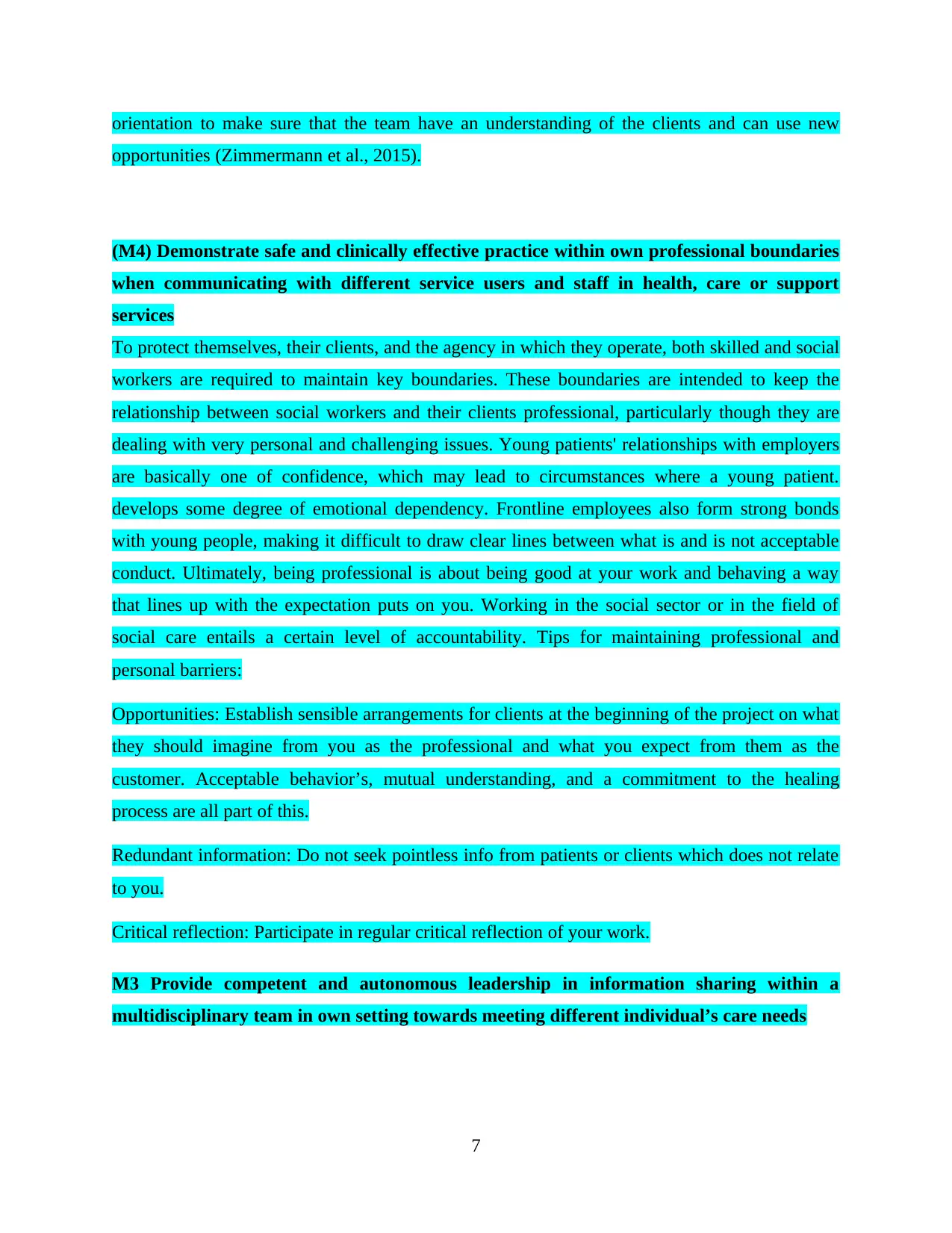
orientation to make sure that the team have an understanding of the clients and can use new
opportunities (Zimmermann et al., 2015).
(M4) Demonstrate safe and clinically effective practice within own professional boundaries
when communicating with different service users and staff in health, care or support
services
To protect themselves, their clients, and the agency in which they operate, both skilled and social
workers are required to maintain key boundaries. These boundaries are intended to keep the
relationship between social workers and their clients professional, particularly though they are
dealing with very personal and challenging issues. Young patients' relationships with employers
are basically one of confidence, which may lead to circumstances where a young patient.
develops some degree of emotional dependency. Frontline employees also form strong bonds
with young people, making it difficult to draw clear lines between what is and is not acceptable
conduct. Ultimately, being professional is about being good at your work and behaving a way
that lines up with the expectation puts on you. Working in the social sector or in the field of
social care entails a certain level of accountability. Tips for maintaining professional and
personal barriers:
Opportunities: Establish sensible arrangements for clients at the beginning of the project on what
they should imagine from you as the professional and what you expect from them as the
customer. Acceptable behavior’s, mutual understanding, and a commitment to the healing
process are all part of this.
Redundant information: Do not seek pointless info from patients or clients which does not relate
to you.
Critical reflection: Participate in regular critical reflection of your work.
M3 Provide competent and autonomous leadership in information sharing within a
multidisciplinary team in own setting towards meeting different individual’s care needs
7
opportunities (Zimmermann et al., 2015).
(M4) Demonstrate safe and clinically effective practice within own professional boundaries
when communicating with different service users and staff in health, care or support
services
To protect themselves, their clients, and the agency in which they operate, both skilled and social
workers are required to maintain key boundaries. These boundaries are intended to keep the
relationship between social workers and their clients professional, particularly though they are
dealing with very personal and challenging issues. Young patients' relationships with employers
are basically one of confidence, which may lead to circumstances where a young patient.
develops some degree of emotional dependency. Frontline employees also form strong bonds
with young people, making it difficult to draw clear lines between what is and is not acceptable
conduct. Ultimately, being professional is about being good at your work and behaving a way
that lines up with the expectation puts on you. Working in the social sector or in the field of
social care entails a certain level of accountability. Tips for maintaining professional and
personal barriers:
Opportunities: Establish sensible arrangements for clients at the beginning of the project on what
they should imagine from you as the professional and what you expect from them as the
customer. Acceptable behavior’s, mutual understanding, and a commitment to the healing
process are all part of this.
Redundant information: Do not seek pointless info from patients or clients which does not relate
to you.
Critical reflection: Participate in regular critical reflection of your work.
M3 Provide competent and autonomous leadership in information sharing within a
multidisciplinary team in own setting towards meeting different individual’s care needs
7
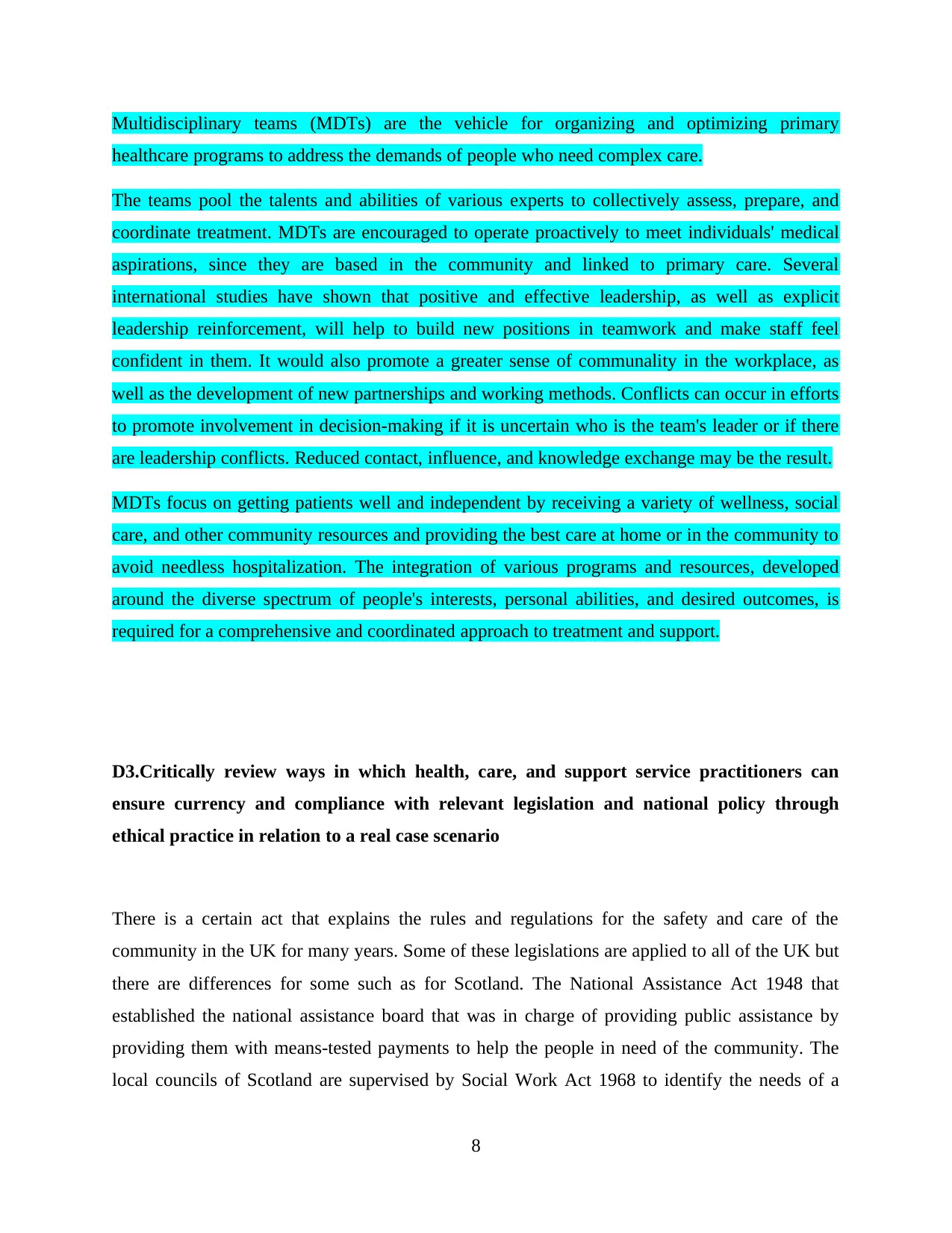
Multidisciplinary teams (MDTs) are the vehicle for organizing and optimizing primary
healthcare programs to address the demands of people who need complex care.
The teams pool the talents and abilities of various experts to collectively assess, prepare, and
coordinate treatment. MDTs are encouraged to operate proactively to meet individuals' medical
aspirations, since they are based in the community and linked to primary care. Several
international studies have shown that positive and effective leadership, as well as explicit
leadership reinforcement, will help to build new positions in teamwork and make staff feel
confident in them. It would also promote a greater sense of communality in the workplace, as
well as the development of new partnerships and working methods. Conflicts can occur in efforts
to promote involvement in decision-making if it is uncertain who is the team's leader or if there
are leadership conflicts. Reduced contact, influence, and knowledge exchange may be the result.
MDTs focus on getting patients well and independent by receiving a variety of wellness, social
care, and other community resources and providing the best care at home or in the community to
avoid needless hospitalization. The integration of various programs and resources, developed
around the diverse spectrum of people's interests, personal abilities, and desired outcomes, is
required for a comprehensive and coordinated approach to treatment and support.
D3.Critically review ways in which health, care, and support service practitioners can
ensure currency and compliance with relevant legislation and national policy through
ethical practice in relation to a real case scenario
There is a certain act that explains the rules and regulations for the safety and care of the
community in the UK for many years. Some of these legislations are applied to all of the UK but
there are differences for some such as for Scotland. The National Assistance Act 1948 that
established the national assistance board that was in charge of providing public assistance by
providing them with means-tested payments to help the people in need of the community. The
local councils of Scotland are supervised by Social Work Act 1968 to identify the needs of a
8
healthcare programs to address the demands of people who need complex care.
The teams pool the talents and abilities of various experts to collectively assess, prepare, and
coordinate treatment. MDTs are encouraged to operate proactively to meet individuals' medical
aspirations, since they are based in the community and linked to primary care. Several
international studies have shown that positive and effective leadership, as well as explicit
leadership reinforcement, will help to build new positions in teamwork and make staff feel
confident in them. It would also promote a greater sense of communality in the workplace, as
well as the development of new partnerships and working methods. Conflicts can occur in efforts
to promote involvement in decision-making if it is uncertain who is the team's leader or if there
are leadership conflicts. Reduced contact, influence, and knowledge exchange may be the result.
MDTs focus on getting patients well and independent by receiving a variety of wellness, social
care, and other community resources and providing the best care at home or in the community to
avoid needless hospitalization. The integration of various programs and resources, developed
around the diverse spectrum of people's interests, personal abilities, and desired outcomes, is
required for a comprehensive and coordinated approach to treatment and support.
D3.Critically review ways in which health, care, and support service practitioners can
ensure currency and compliance with relevant legislation and national policy through
ethical practice in relation to a real case scenario
There is a certain act that explains the rules and regulations for the safety and care of the
community in the UK for many years. Some of these legislations are applied to all of the UK but
there are differences for some such as for Scotland. The National Assistance Act 1948 that
established the national assistance board that was in charge of providing public assistance by
providing them with means-tested payments to help the people in need of the community. The
local councils of Scotland are supervised by Social Work Act 1968 to identify the needs of a
8
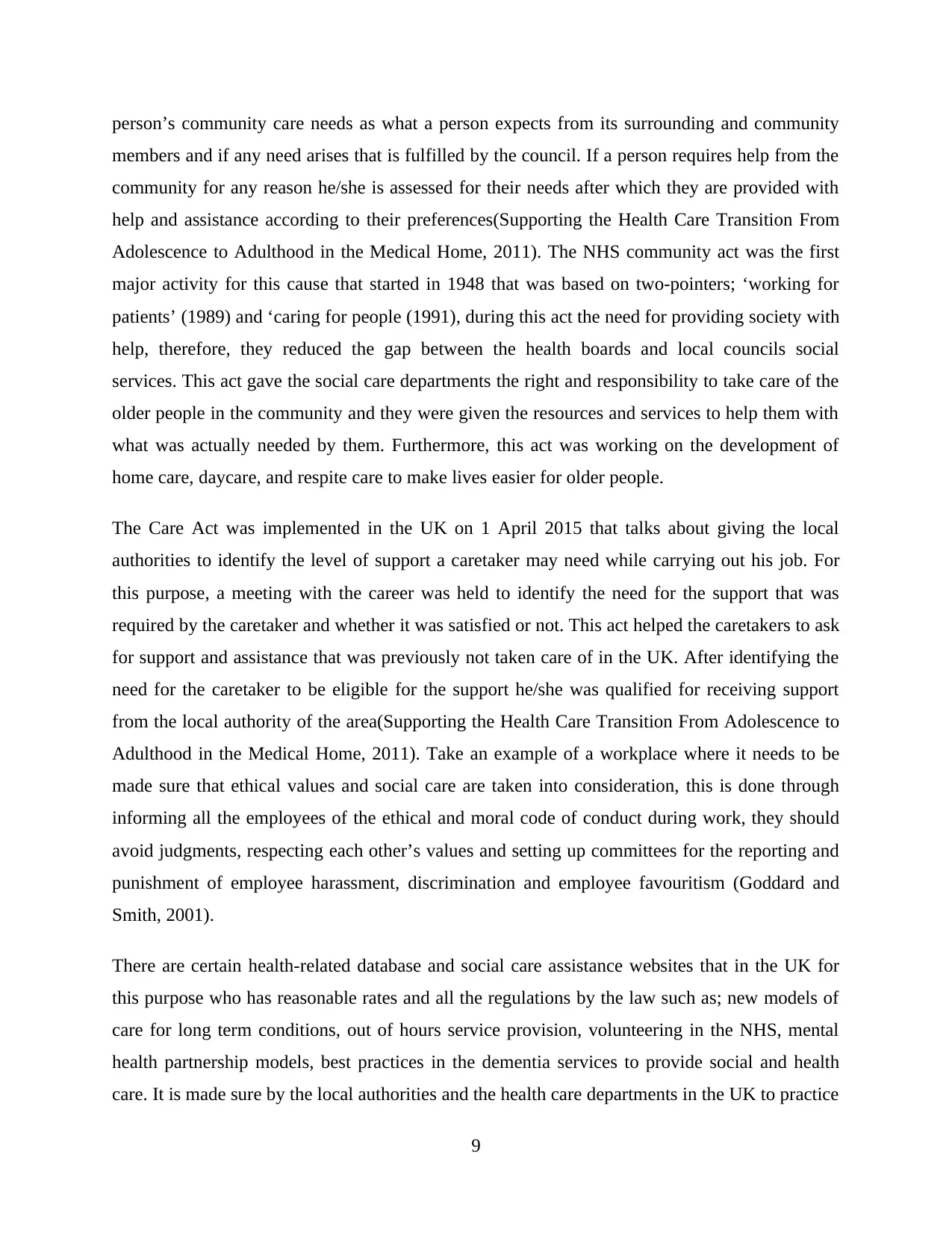
person’s community care needs as what a person expects from its surrounding and community
members and if any need arises that is fulfilled by the council. If a person requires help from the
community for any reason he/she is assessed for their needs after which they are provided with
help and assistance according to their preferences(Supporting the Health Care Transition From
Adolescence to Adulthood in the Medical Home, 2011). The NHS community act was the first
major activity for this cause that started in 1948 that was based on two-pointers; ‘working for
patients’ (1989) and ‘caring for people (1991), during this act the need for providing society with
help, therefore, they reduced the gap between the health boards and local councils social
services. This act gave the social care departments the right and responsibility to take care of the
older people in the community and they were given the resources and services to help them with
what was actually needed by them. Furthermore, this act was working on the development of
home care, daycare, and respite care to make lives easier for older people.
The Care Act was implemented in the UK on 1 April 2015 that talks about giving the local
authorities to identify the level of support a caretaker may need while carrying out his job. For
this purpose, a meeting with the career was held to identify the need for the support that was
required by the caretaker and whether it was satisfied or not. This act helped the caretakers to ask
for support and assistance that was previously not taken care of in the UK. After identifying the
need for the caretaker to be eligible for the support he/she was qualified for receiving support
from the local authority of the area(Supporting the Health Care Transition From Adolescence to
Adulthood in the Medical Home, 2011). Take an example of a workplace where it needs to be
made sure that ethical values and social care are taken into consideration, this is done through
informing all the employees of the ethical and moral code of conduct during work, they should
avoid judgments, respecting each other’s values and setting up committees for the reporting and
punishment of employee harassment, discrimination and employee favouritism (Goddard and
Smith, 2001).
There are certain health-related database and social care assistance websites that in the UK for
this purpose who has reasonable rates and all the regulations by the law such as; new models of
care for long term conditions, out of hours service provision, volunteering in the NHS, mental
health partnership models, best practices in the dementia services to provide social and health
care. It is made sure by the local authorities and the health care departments in the UK to practice
9
members and if any need arises that is fulfilled by the council. If a person requires help from the
community for any reason he/she is assessed for their needs after which they are provided with
help and assistance according to their preferences(Supporting the Health Care Transition From
Adolescence to Adulthood in the Medical Home, 2011). The NHS community act was the first
major activity for this cause that started in 1948 that was based on two-pointers; ‘working for
patients’ (1989) and ‘caring for people (1991), during this act the need for providing society with
help, therefore, they reduced the gap between the health boards and local councils social
services. This act gave the social care departments the right and responsibility to take care of the
older people in the community and they were given the resources and services to help them with
what was actually needed by them. Furthermore, this act was working on the development of
home care, daycare, and respite care to make lives easier for older people.
The Care Act was implemented in the UK on 1 April 2015 that talks about giving the local
authorities to identify the level of support a caretaker may need while carrying out his job. For
this purpose, a meeting with the career was held to identify the need for the support that was
required by the caretaker and whether it was satisfied or not. This act helped the caretakers to ask
for support and assistance that was previously not taken care of in the UK. After identifying the
need for the caretaker to be eligible for the support he/she was qualified for receiving support
from the local authority of the area(Supporting the Health Care Transition From Adolescence to
Adulthood in the Medical Home, 2011). Take an example of a workplace where it needs to be
made sure that ethical values and social care are taken into consideration, this is done through
informing all the employees of the ethical and moral code of conduct during work, they should
avoid judgments, respecting each other’s values and setting up committees for the reporting and
punishment of employee harassment, discrimination and employee favouritism (Goddard and
Smith, 2001).
There are certain health-related database and social care assistance websites that in the UK for
this purpose who has reasonable rates and all the regulations by the law such as; new models of
care for long term conditions, out of hours service provision, volunteering in the NHS, mental
health partnership models, best practices in the dementia services to provide social and health
care. It is made sure by the local authorities and the health care departments in the UK to practice
9
Secure Best Marks with AI Grader
Need help grading? Try our AI Grader for instant feedback on your assignments.
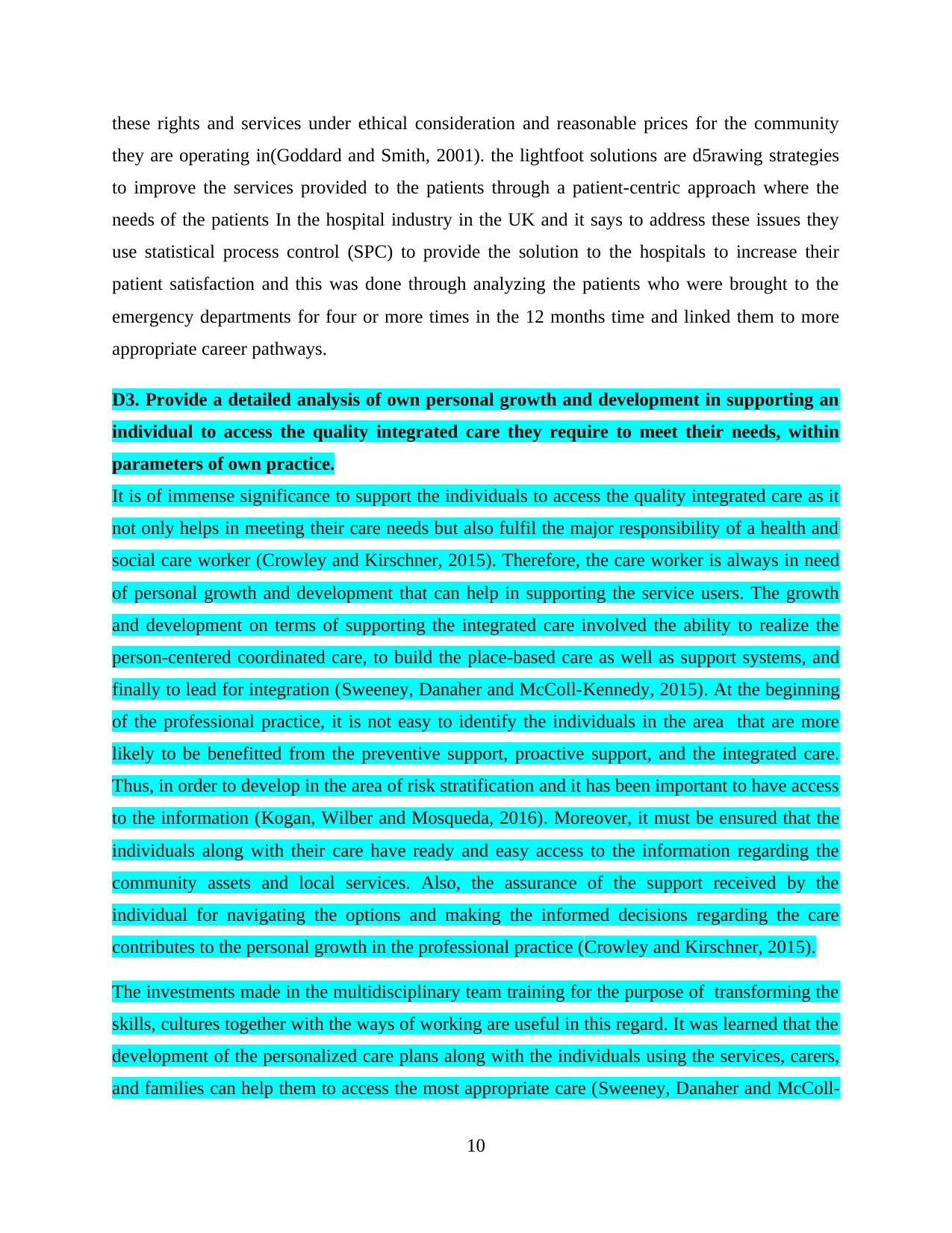
these rights and services under ethical consideration and reasonable prices for the community
they are operating in(Goddard and Smith, 2001). the lightfoot solutions are d5rawing strategies
to improve the services provided to the patients through a patient-centric approach where the
needs of the patients In the hospital industry in the UK and it says to address these issues they
use statistical process control (SPC) to provide the solution to the hospitals to increase their
patient satisfaction and this was done through analyzing the patients who were brought to the
emergency departments for four or more times in the 12 months time and linked them to more
appropriate career pathways.
D3. Provide a detailed analysis of own personal growth and development in supporting an
individual to access the quality integrated care they require to meet their needs, within
parameters of own practice.
It is of immense significance to support the individuals to access the quality integrated care as it
not only helps in meeting their care needs but also fulfil the major responsibility of a health and
social care worker (Crowley and Kirschner, 2015). Therefore, the care worker is always in need
of personal growth and development that can help in supporting the service users. The growth
and development on terms of supporting the integrated care involved the ability to realize the
person-centered coordinated care, to build the place-based care as well as support systems, and
finally to lead for integration (Sweeney, Danaher and McColl-Kennedy, 2015). At the beginning
of the professional practice, it is not easy to identify the individuals in the area that are more
likely to be benefitted from the preventive support, proactive support, and the integrated care.
Thus, in order to develop in the area of risk stratification and it has been important to have access
to the information (Kogan, Wilber and Mosqueda, 2016). Moreover, it must be ensured that the
individuals along with their care have ready and easy access to the information regarding the
community assets and local services. Also, the assurance of the support received by the
individual for navigating the options and making the informed decisions regarding the care
contributes to the personal growth in the professional practice (Crowley and Kirschner, 2015).
The investments made in the multidisciplinary team training for the purpose of transforming the
skills, cultures together with the ways of working are useful in this regard. It was learned that the
development of the personalized care plans along with the individuals using the services, carers,
and families can help them to access the most appropriate care (Sweeney, Danaher and McColl-
10
they are operating in(Goddard and Smith, 2001). the lightfoot solutions are d5rawing strategies
to improve the services provided to the patients through a patient-centric approach where the
needs of the patients In the hospital industry in the UK and it says to address these issues they
use statistical process control (SPC) to provide the solution to the hospitals to increase their
patient satisfaction and this was done through analyzing the patients who were brought to the
emergency departments for four or more times in the 12 months time and linked them to more
appropriate career pathways.
D3. Provide a detailed analysis of own personal growth and development in supporting an
individual to access the quality integrated care they require to meet their needs, within
parameters of own practice.
It is of immense significance to support the individuals to access the quality integrated care as it
not only helps in meeting their care needs but also fulfil the major responsibility of a health and
social care worker (Crowley and Kirschner, 2015). Therefore, the care worker is always in need
of personal growth and development that can help in supporting the service users. The growth
and development on terms of supporting the integrated care involved the ability to realize the
person-centered coordinated care, to build the place-based care as well as support systems, and
finally to lead for integration (Sweeney, Danaher and McColl-Kennedy, 2015). At the beginning
of the professional practice, it is not easy to identify the individuals in the area that are more
likely to be benefitted from the preventive support, proactive support, and the integrated care.
Thus, in order to develop in the area of risk stratification and it has been important to have access
to the information (Kogan, Wilber and Mosqueda, 2016). Moreover, it must be ensured that the
individuals along with their care have ready and easy access to the information regarding the
community assets and local services. Also, the assurance of the support received by the
individual for navigating the options and making the informed decisions regarding the care
contributes to the personal growth in the professional practice (Crowley and Kirschner, 2015).
The investments made in the multidisciplinary team training for the purpose of transforming the
skills, cultures together with the ways of working are useful in this regard. It was learned that the
development of the personalized care plans along with the individuals using the services, carers,
and families can help them to access the most appropriate care (Sweeney, Danaher and McColl-
10

Kennedy, 2015). On the other hand, rapid responses are effective in this realization phases. The
service providers should be capable of providing access to the integrated rapid response through
the single-point of access for the urgent social and health care needs of an individual (Crowley
and Kirschner, 2015). Apart from this, building of the place0based care and support systems
require the expertise of the operational frameworks, integrated commissioning, shared records,
community capacity, and partnership with the social, voluntary and community sectors (Asarnow
et al., 2015).
It is important to develop an integrated care operational framework which is particularly suitable
for the local areas and shows alignment with the services changes and service delivery to a
defined set of pros for the local patients (Asarnow et al., 2015). The use of integrated
commissioning helps in enabling the ready access of the care provided to the joined-up social
and health care resources and ultimately in the transformation of the care being provided
(Sklenarova et al., 2015). Furthermore, the growth and development in supporting for the access
to integrated care can be reflected by the capabilities to determine and address the barriers to
sharing the digital care records of the patients in order to ensure that the practitioners and
providers have the access to the information required (Sklenarova et al., 2015).
It has been determined that the building capability for the integrated community-based health,
mental health, and social care services, stressing on the care closer to home contributes
significantly as the best practice action for promoting and integrating the accessible integrated
care for the individuals in dire need (Kruk et al., 2018). The next and the most significant step
includes leading for integration. It is crucial for the practitioners to agree a shared vision and a
common purpose for integration that involve the establishment of clear goals and health
outcomes (Lee and Coughlin, 2015). In addition to this, promoting the aculture manifested by
collaboration cross the social, health, and wide partners can be a source for support for the
individuals to access the integrated care capable of meeting the significant care needs (Lee and
Coughlin, 2015). The growth and development can also be evident from the ability to
appropriately allocate resources. The maintenance of a cross sector agreement regarding the
available resources for the purpose of delivering the model of care involving community assets is
an integral aspect of leading for integration. Apar from this, the development of accountability.
Integrity, as well as the workforce planning are crucial in this context (Kruk et al., 2018).
11
service providers should be capable of providing access to the integrated rapid response through
the single-point of access for the urgent social and health care needs of an individual (Crowley
and Kirschner, 2015). Apart from this, building of the place0based care and support systems
require the expertise of the operational frameworks, integrated commissioning, shared records,
community capacity, and partnership with the social, voluntary and community sectors (Asarnow
et al., 2015).
It is important to develop an integrated care operational framework which is particularly suitable
for the local areas and shows alignment with the services changes and service delivery to a
defined set of pros for the local patients (Asarnow et al., 2015). The use of integrated
commissioning helps in enabling the ready access of the care provided to the joined-up social
and health care resources and ultimately in the transformation of the care being provided
(Sklenarova et al., 2015). Furthermore, the growth and development in supporting for the access
to integrated care can be reflected by the capabilities to determine and address the barriers to
sharing the digital care records of the patients in order to ensure that the practitioners and
providers have the access to the information required (Sklenarova et al., 2015).
It has been determined that the building capability for the integrated community-based health,
mental health, and social care services, stressing on the care closer to home contributes
significantly as the best practice action for promoting and integrating the accessible integrated
care for the individuals in dire need (Kruk et al., 2018). The next and the most significant step
includes leading for integration. It is crucial for the practitioners to agree a shared vision and a
common purpose for integration that involve the establishment of clear goals and health
outcomes (Lee and Coughlin, 2015). In addition to this, promoting the aculture manifested by
collaboration cross the social, health, and wide partners can be a source for support for the
individuals to access the integrated care capable of meeting the significant care needs (Lee and
Coughlin, 2015). The growth and development can also be evident from the ability to
appropriately allocate resources. The maintenance of a cross sector agreement regarding the
available resources for the purpose of delivering the model of care involving community assets is
an integral aspect of leading for integration. Apar from this, the development of accountability.
Integrity, as well as the workforce planning are crucial in this context (Kruk et al., 2018).
11
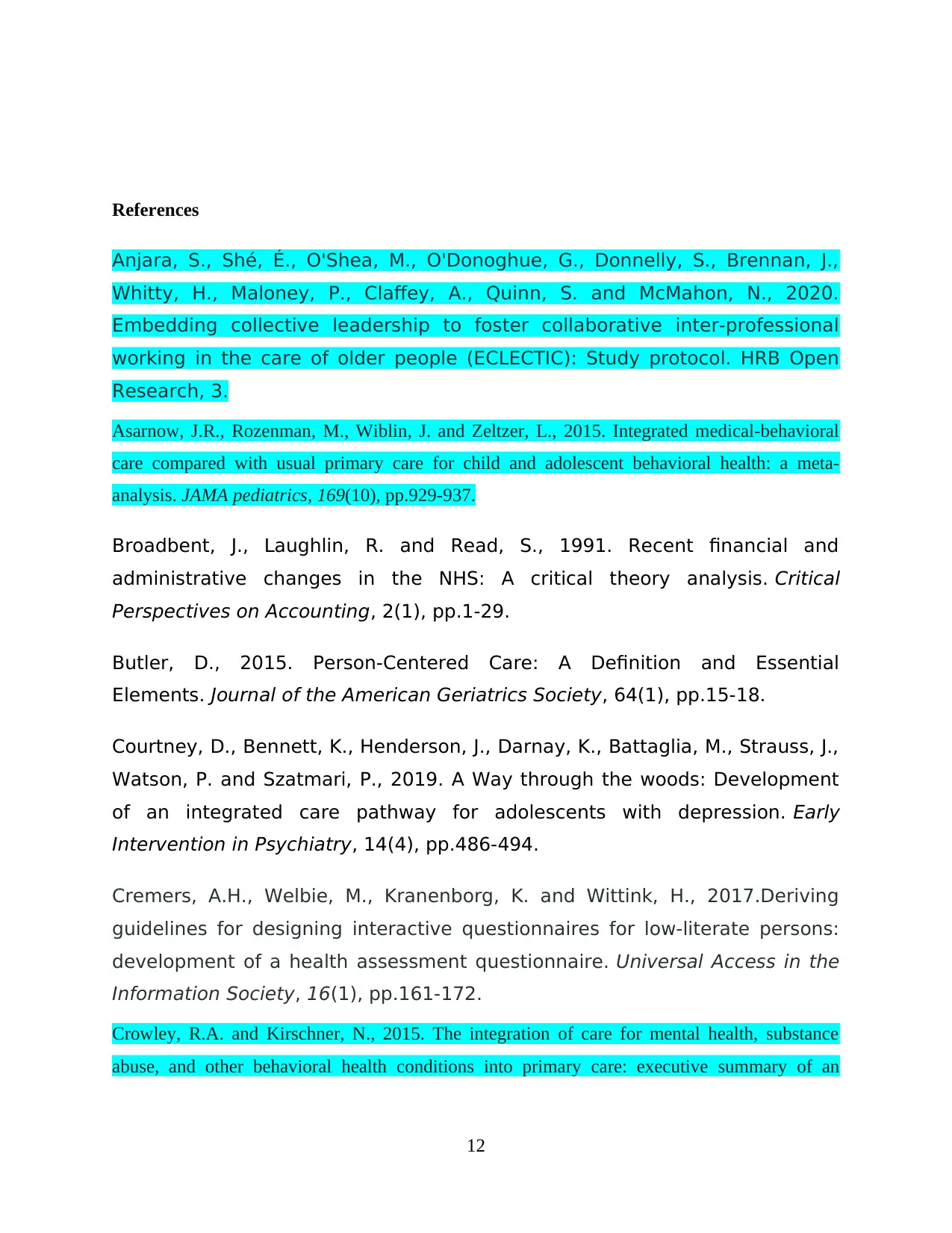
References
Anjara, S., Shé, É., O'Shea, M., O'Donoghue, G., Donnelly, S., Brennan, J.,
Whitty, H., Maloney, P., Claffey, A., Quinn, S. and McMahon, N., 2020.
Embedding collective leadership to foster collaborative inter-professional
working in the care of older people (ECLECTIC): Study protocol. HRB Open
Research, 3.
Asarnow, J.R., Rozenman, M., Wiblin, J. and Zeltzer, L., 2015. Integrated medical-behavioral
care compared with usual primary care for child and adolescent behavioral health: a meta-
analysis. JAMA pediatrics, 169(10), pp.929-937.
Broadbent, J., Laughlin, R. and Read, S., 1991. Recent financial and
administrative changes in the NHS: A critical theory analysis. Critical
Perspectives on Accounting, 2(1), pp.1-29.
Butler, D., 2015. Person-Centered Care: A Definition and Essential
Elements. Journal of the American Geriatrics Society, 64(1), pp.15-18.
Courtney, D., Bennett, K., Henderson, J., Darnay, K., Battaglia, M., Strauss, J.,
Watson, P. and Szatmari, P., 2019. A Way through the woods: Development
of an integrated care pathway for adolescents with depression. Early
Intervention in Psychiatry, 14(4), pp.486-494.
Cremers, A.H., Welbie, M., Kranenborg, K. and Wittink, H., 2017.Deriving
guidelines for designing interactive questionnaires for low-literate persons:
development of a health assessment questionnaire. Universal Access in the
Information Society, 16(1), pp.161-172.
Crowley, R.A. and Kirschner, N., 2015. The integration of care for mental health, substance
abuse, and other behavioral health conditions into primary care: executive summary of an
12
Anjara, S., Shé, É., O'Shea, M., O'Donoghue, G., Donnelly, S., Brennan, J.,
Whitty, H., Maloney, P., Claffey, A., Quinn, S. and McMahon, N., 2020.
Embedding collective leadership to foster collaborative inter-professional
working in the care of older people (ECLECTIC): Study protocol. HRB Open
Research, 3.
Asarnow, J.R., Rozenman, M., Wiblin, J. and Zeltzer, L., 2015. Integrated medical-behavioral
care compared with usual primary care for child and adolescent behavioral health: a meta-
analysis. JAMA pediatrics, 169(10), pp.929-937.
Broadbent, J., Laughlin, R. and Read, S., 1991. Recent financial and
administrative changes in the NHS: A critical theory analysis. Critical
Perspectives on Accounting, 2(1), pp.1-29.
Butler, D., 2015. Person-Centered Care: A Definition and Essential
Elements. Journal of the American Geriatrics Society, 64(1), pp.15-18.
Courtney, D., Bennett, K., Henderson, J., Darnay, K., Battaglia, M., Strauss, J.,
Watson, P. and Szatmari, P., 2019. A Way through the woods: Development
of an integrated care pathway for adolescents with depression. Early
Intervention in Psychiatry, 14(4), pp.486-494.
Cremers, A.H., Welbie, M., Kranenborg, K. and Wittink, H., 2017.Deriving
guidelines for designing interactive questionnaires for low-literate persons:
development of a health assessment questionnaire. Universal Access in the
Information Society, 16(1), pp.161-172.
Crowley, R.A. and Kirschner, N., 2015. The integration of care for mental health, substance
abuse, and other behavioral health conditions into primary care: executive summary of an
12
Paraphrase This Document
Need a fresh take? Get an instant paraphrase of this document with our AI Paraphraser
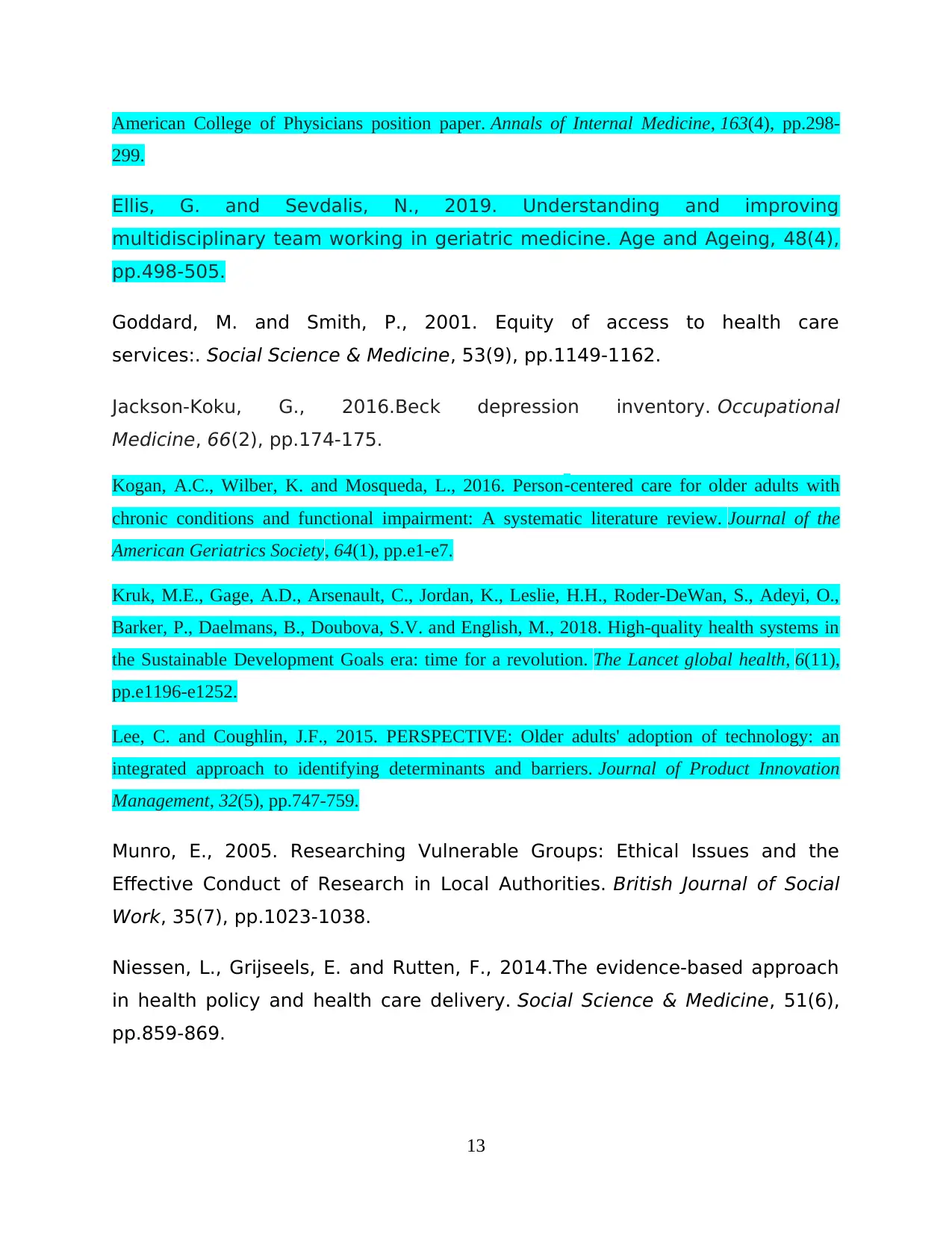
American College of Physicians position paper. Annals of Internal Medicine, 163(4), pp.298-
299.
Ellis, G. and Sevdalis, N., 2019. Understanding and improving
multidisciplinary team working in geriatric medicine. Age and Ageing, 48(4),
pp.498-505.
Goddard, M. and Smith, P., 2001. Equity of access to health care
services:. Social Science & Medicine, 53(9), pp.1149-1162.
Jackson-Koku, G., 2016.Beck depression inventory. Occupational
Medicine, 66(2), pp.174-175.
Kogan, A.C., Wilber, K. and Mosqueda, L., 2016. Person‐centered care for older adults with
chronic conditions and functional impairment: A systematic literature review. Journal of the
American Geriatrics Society, 64(1), pp.e1-e7.
Kruk, M.E., Gage, A.D., Arsenault, C., Jordan, K., Leslie, H.H., Roder-DeWan, S., Adeyi, O.,
Barker, P., Daelmans, B., Doubova, S.V. and English, M., 2018. High-quality health systems in
the Sustainable Development Goals era: time for a revolution. The Lancet global health, 6(11),
pp.e1196-e1252.
Lee, C. and Coughlin, J.F., 2015. PERSPECTIVE: Older adults' adoption of technology: an
integrated approach to identifying determinants and barriers. Journal of Product Innovation
Management, 32(5), pp.747-759.
Munro, E., 2005. Researching Vulnerable Groups: Ethical Issues and the
Effective Conduct of Research in Local Authorities. British Journal of Social
Work, 35(7), pp.1023-1038.
Niessen, L., Grijseels, E. and Rutten, F., 2014.The evidence-based approach
in health policy and health care delivery. Social Science & Medicine, 51(6),
pp.859-869.
13
299.
Ellis, G. and Sevdalis, N., 2019. Understanding and improving
multidisciplinary team working in geriatric medicine. Age and Ageing, 48(4),
pp.498-505.
Goddard, M. and Smith, P., 2001. Equity of access to health care
services:. Social Science & Medicine, 53(9), pp.1149-1162.
Jackson-Koku, G., 2016.Beck depression inventory. Occupational
Medicine, 66(2), pp.174-175.
Kogan, A.C., Wilber, K. and Mosqueda, L., 2016. Person‐centered care for older adults with
chronic conditions and functional impairment: A systematic literature review. Journal of the
American Geriatrics Society, 64(1), pp.e1-e7.
Kruk, M.E., Gage, A.D., Arsenault, C., Jordan, K., Leslie, H.H., Roder-DeWan, S., Adeyi, O.,
Barker, P., Daelmans, B., Doubova, S.V. and English, M., 2018. High-quality health systems in
the Sustainable Development Goals era: time for a revolution. The Lancet global health, 6(11),
pp.e1196-e1252.
Lee, C. and Coughlin, J.F., 2015. PERSPECTIVE: Older adults' adoption of technology: an
integrated approach to identifying determinants and barriers. Journal of Product Innovation
Management, 32(5), pp.747-759.
Munro, E., 2005. Researching Vulnerable Groups: Ethical Issues and the
Effective Conduct of Research in Local Authorities. British Journal of Social
Work, 35(7), pp.1023-1038.
Niessen, L., Grijseels, E. and Rutten, F., 2014.The evidence-based approach
in health policy and health care delivery. Social Science & Medicine, 51(6),
pp.859-869.
13
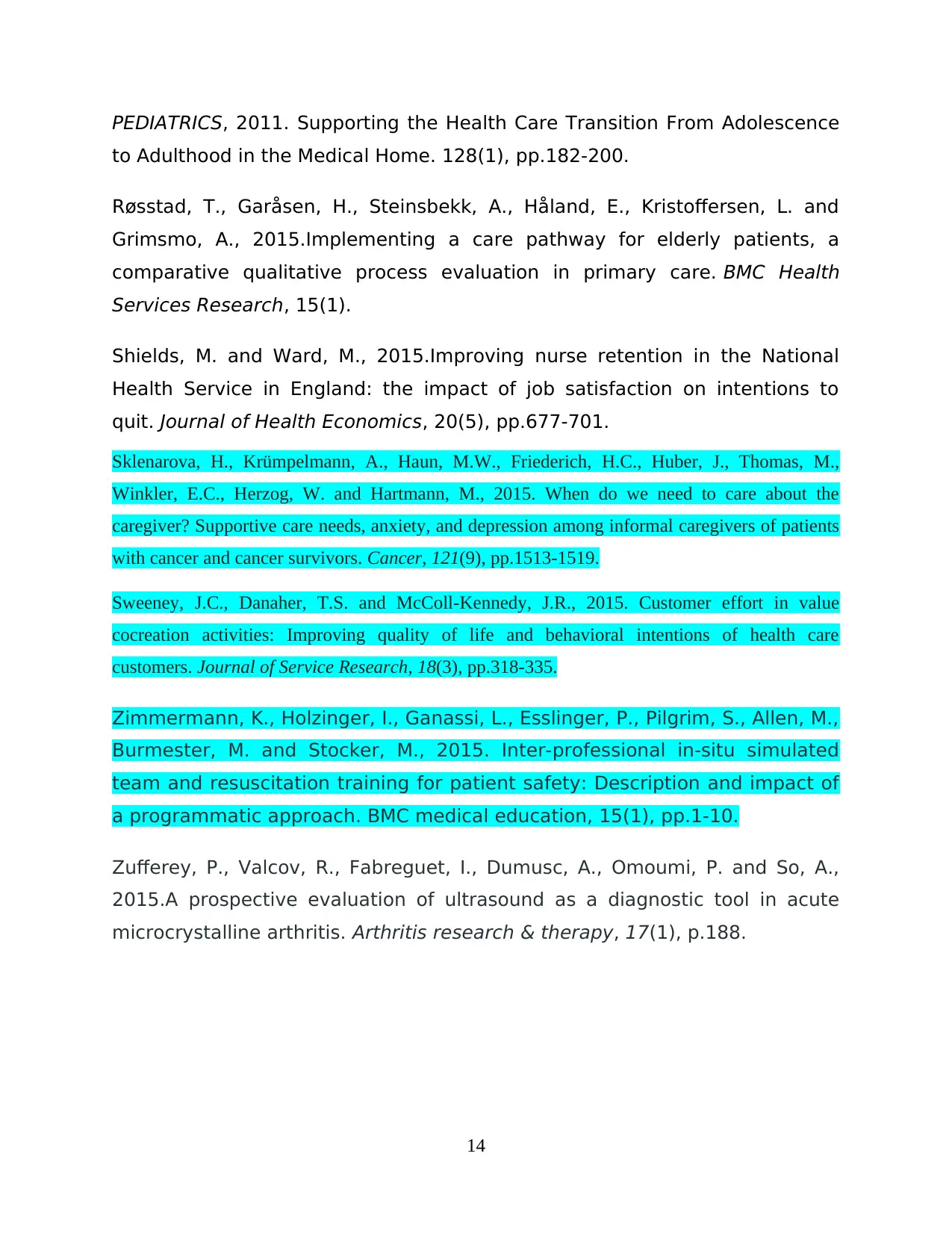
PEDIATRICS, 2011. Supporting the Health Care Transition From Adolescence
to Adulthood in the Medical Home. 128(1), pp.182-200.
Røsstad, T., Garåsen, H., Steinsbekk, A., Håland, E., Kristoffersen, L. and
Grimsmo, A., 2015.Implementing a care pathway for elderly patients, a
comparative qualitative process evaluation in primary care. BMC Health
Services Research, 15(1).
Shields, M. and Ward, M., 2015.Improving nurse retention in the National
Health Service in England: the impact of job satisfaction on intentions to
quit. Journal of Health Economics, 20(5), pp.677-701.
Sklenarova, H., Krümpelmann, A., Haun, M.W., Friederich, H.C., Huber, J., Thomas, M.,
Winkler, E.C., Herzog, W. and Hartmann, M., 2015. When do we need to care about the
caregiver? Supportive care needs, anxiety, and depression among informal caregivers of patients
with cancer and cancer survivors. Cancer, 121(9), pp.1513-1519.
Sweeney, J.C., Danaher, T.S. and McColl-Kennedy, J.R., 2015. Customer effort in value
cocreation activities: Improving quality of life and behavioral intentions of health care
customers. Journal of Service Research, 18(3), pp.318-335.
Zimmermann, K., Holzinger, I., Ganassi, L., Esslinger, P., Pilgrim, S., Allen, M.,
Burmester, M. and Stocker, M., 2015. Inter-professional in-situ simulated
team and resuscitation training for patient safety: Description and impact of
a programmatic approach. BMC medical education, 15(1), pp.1-10.
Zufferey, P., Valcov, R., Fabreguet, I., Dumusc, A., Omoumi, P. and So, A.,
2015.A prospective evaluation of ultrasound as a diagnostic tool in acute
microcrystalline arthritis. Arthritis research & therapy, 17(1), p.188.
14
to Adulthood in the Medical Home. 128(1), pp.182-200.
Røsstad, T., Garåsen, H., Steinsbekk, A., Håland, E., Kristoffersen, L. and
Grimsmo, A., 2015.Implementing a care pathway for elderly patients, a
comparative qualitative process evaluation in primary care. BMC Health
Services Research, 15(1).
Shields, M. and Ward, M., 2015.Improving nurse retention in the National
Health Service in England: the impact of job satisfaction on intentions to
quit. Journal of Health Economics, 20(5), pp.677-701.
Sklenarova, H., Krümpelmann, A., Haun, M.W., Friederich, H.C., Huber, J., Thomas, M.,
Winkler, E.C., Herzog, W. and Hartmann, M., 2015. When do we need to care about the
caregiver? Supportive care needs, anxiety, and depression among informal caregivers of patients
with cancer and cancer survivors. Cancer, 121(9), pp.1513-1519.
Sweeney, J.C., Danaher, T.S. and McColl-Kennedy, J.R., 2015. Customer effort in value
cocreation activities: Improving quality of life and behavioral intentions of health care
customers. Journal of Service Research, 18(3), pp.318-335.
Zimmermann, K., Holzinger, I., Ganassi, L., Esslinger, P., Pilgrim, S., Allen, M.,
Burmester, M. and Stocker, M., 2015. Inter-professional in-situ simulated
team and resuscitation training for patient safety: Description and impact of
a programmatic approach. BMC medical education, 15(1), pp.1-10.
Zufferey, P., Valcov, R., Fabreguet, I., Dumusc, A., Omoumi, P. and So, A.,
2015.A prospective evaluation of ultrasound as a diagnostic tool in acute
microcrystalline arthritis. Arthritis research & therapy, 17(1), p.188.
14
1 out of 15
Related Documents
Your All-in-One AI-Powered Toolkit for Academic Success.
+13062052269
info@desklib.com
Available 24*7 on WhatsApp / Email
![[object Object]](/_next/static/media/star-bottom.7253800d.svg)
Unlock your academic potential
© 2024 | Zucol Services PVT LTD | All rights reserved.





